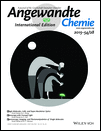Hyperbranched Hybridization Chain Reaction for Triggered Signal Amplification and Concatenated Logic Circuits†
This work was supported by the National Science Foundation of China (21375056) and the Program for New Century Excellent Talents in University of the Ministry of Education of China (NCET-12-1024).
Graphical Abstract
DNA branches out: A hyperbranched hybridization chain reaction is reported for the self-assembly of dendritic DNA structures triggered by an initiator DNA strand. By using this method, ultrasensitive detection of target DNA was achieved and three-input concatenated logic circuits have been constructed which can operate as keypad locks for biocomputing security systems at the molecular level.
Abstract
A hyper-branched hybridization chain reaction (HB-HCR) is presented herein, which consists of only six species that can metastably coexist until the introduction of an initiator DNA to trigger a cascade of hybridization events, leading to the self-sustained assembly of hyper-branched and nicked double-stranded DNA structures. The system can readily achieve ultrasensitive detection of target DNA. Moreover, the HB-HCR principle is successfully applied to construct three-input concatenated logic circuits with excellent specificity and extended to design a security-mimicking keypad lock system. Significantly, the HB-HCR-based keypad lock can alarm immediately if the “password” is incorrect. Overall, the proposed HB-HCR with high amplification efficiency is simple, homogeneous, fast, robust, and low-cost, and holds great promise in the development of biosensing, in the programmable assembly of DNA architectures, and in molecular logic operations.





